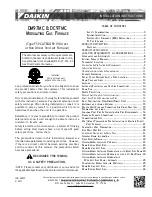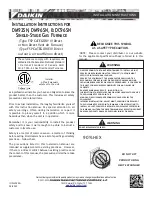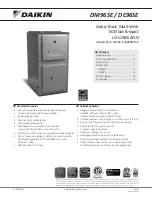
Page 45
Other Unit Adjustments
Primary Limit
.
The primary limit is located on the heating compartment
vestibule panel. This limit is factory set and requires no ad
justment.
Flame Rollout Switches (Two)
These manually reset switches are located on the front of
the burner box.
Pressure Switch
The pressure switch is located in the heating compartment
on the cold end header box. This switch checks for proper
combustion air inducer operation before allowing ignition
trial. The switch is factory-set and must not be adjusted.
Temperature Rise
Place the unit into operation with a second-stage heating
demand. After supply and return air temperatures have
stabilized, check the temperature rise. If necessary, adjust
the heating blower speed to maintain the temperature rise
within the range shown on the unit nameplate. Increase the
blower speed to decrease the temperature rise. Decrease
the blower speed to increase the temperature rise. Failure
to properly adjust the temperature rise may cause erratic
limit operation.
Thermostat Heat Anticipation
Set the heat anticipator setting (if adjustable) according to
the amp draw listed on the wiring diagram that is attached
to the unit.
Electrical
1 - Check all wiring for loose connections.
2 - Check for the correct voltage at the furnace (furnace
operating). Correct voltage is 10%
3 - Check amp-draw on the blower motor with blower ac
cess panel in place.
Unit Nameplate__________Actual__________
Exhaust and Air Intake Pipe
1 - Check exhaust and air intake connections for tightness
and to make sure there is no blockage.
2 - Is pressure switch closed? Obstructed exhaust pipe
will cause unit to shut off at pressure switch. Check ter
mination for blockages.
3 - Obstructed pipe or termination may cause rollout
switches to open. Reset manual flame rollout switches
on burner box assembly if necessary.
Sequence of Operation
On a call for heat from the room thermostat, the control
board performs a 1 second self check. Upon confirmation
that the pressure switch contacts are in an open position,
the control energizes the combustion blower on high
speed. The control then checks for adequate combustion
air by making sure the low-fire pressure switch contacts are
closed.
The igniter energizes and is allowed to warm up for 20 sec
onds before the gas valve energizes on 1st stage and burn
ers ignite. 45 seconds after the control confirms ignition
has occurred, the control drops the combustion blower to
low speed.
The circulating blower ramps up to 50% of 1st stage heat
speed and operates at that speed for one minute (including
ramp up time), then at 75% of 1st stage heat speed for an
additional minute. After that, the circulating blower oper
ates at full 1st stage heat speed until either the heat call is
satisfied or the thermostat initiates a call for 2nd stage heat.
On a call for 2nd stage heat, the control energizes the circu
lating air blower on full CFM 2nd stage heat.
If the automatic heat staging option is being used the fur
nace does not switch to 2nd stage heat in response to a call
from the thermostat but instead operates at 1st stage heat
for the duration of the selected time before automatically
switching to 2nd stage heat.
When the call for heat is satisfied, the gas valve and com
bustion air blower shut down. The control board shuts off
the gas valve and runs the combustion blower for an addi
tional 15 seconds. The circulating air blower continues to
run for 2 minutes at 82% of the selected heating speed (low
fire or high fire) before ramping down.
In the event the unit loses ignition, the control will attempt to
recycle up to five times before it goes into a 1 hour lockout.
Lockout may be manually reset by removing power from
the control for more than 1 second or removing the thermo
stat call for heat for more than 3 seconds.
If during a heating cycle the limit control senses an abnor
mally high temperature and opens, the control board de-
energizes the gas valve and the combustion blower while
the circulating blower ramps up to 2nd stage heat speed.
The circulating blower remains energized until the limits
are closed.
Fan On
When the thermostat is set for continuous fan operation
and there is no demand for heating or cooling, a call for fan
closes the R to G circuit and the circulating blower motor
runs at50% of the selected cooling CFM until switched off.
When the call for fan is turned off, the control de-energizes
the circulating blower.
Cooling
The unit is set up at the factory for single stage cooling. For
two stage cooling operation, clip the jumper wire located
between the Y to Y2 terminals on the integrated ignition/
blower control board. If the active dehumidification feature
is enabled, the circulating blower runs at 70% of the se
lected cooling speed as long as there is a call for dehumidi
fication.








































